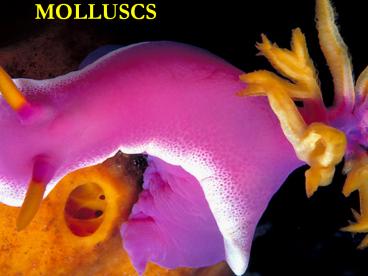MOLLUSCS - PowerPoint PPT Presentation
1 / 16
Title:
MOLLUSCS
Description:
Phylum Mollusca Subphylum Amphineura Class Polyplacophora ... Camb-Perm Class Bivalvia clams, oysters Class Scaphopods tusk shells All major groups ... – PowerPoint PPT presentation
Number of Views:491
Avg rating:3.0/5.0
Title: MOLLUSCS
1
MOLLUSCS
2
Phylum Mollusca Subphylum Amphineura Class
Polyplacophora chitins Subphylum
Cyrtosoma Class Monoplacophora almost
extinct Class Gastropoda snails Class
Cephalopoda squid, nautilus Subphylum
Diasoma Class Rostroconchia Camb-Perm Class
Bivalvia clams, oysters Class Scaphopods
tusk shells All major groups (ex scaphopods)
appear in Cambrian, became important part of
Mesozoic/Cenozoic faunas
3
Common features unsegmented body bilaterally
symmetrical head (most) - contains sensory
organs radula - with primarily organic
teeth foot crawling, burrowing, or
grasping mantle fleshy covering which secretes
shell shell (when present) periostracum/calcareou
s prismatic layer/nacreous layer gills in
chamber in mantle Phylogeny poorly understood
4
H.A.M. Hypothetical Ancestral Mollusc
5
Diasoma through body
Cyrtosoma curved body
rostroconchs
6
Polyplacophora body covered by 8 overlapping
plates poor fossil record on eyes or
tentacles, marine
Monoplacophora faintly segmented body covered by
cap-shaped shell Cambrian-Devonian, Recent (1952)
7
Gastropods prosobranchs (forward gills)
marine opisthobranchs (rear gills) reduced
shells pulmonates (lungs) air
breathers Habitats/niches scape algae with
radula scavengers/ detritus feeders
predators (drills/harpoons) suspension feeders
8
- Torsion
- Nerve cord in fig-8
- Left/right gills reversed in cavity over head
- Anus above head fouling problems
9
Water circulation
10
- Reasons for torsion
- Larval retraction larvae could retract head into
mantle no real advantage. - Larval settling aids larva to balance shell over
head evidence contradicts - Veliger swimming balance body mass for swimming
- ? - Adapted adult good for adult to have everything
up front primitive ones dont - Adult retraction allowed retraction into mantle
cavity, closed by operculum doesnt work for
primitive - Helicospiral coiling better balance asymmetrical
shell doesnt explain limpets
11
(No Transcript)
12
GASTROPODS
Hyperstrophic dextral right-handed, whorls to
left, carried diagonal, spire to
front Orthostrophic dextral whorls to right,
carried diagonal, spire to back
13
PROSOBRANCHS
Archaeogastropods - Primitive forms in which
there are two auricles, two kidneys and two gills
present. Nerve system is never concentrated.
Shell is either coiled or secondarily symmetrical
as in the limpets. Largely marine but there are
a few that inhabit brackish water, freshwater or
even terrestrial habitats.
14
Mesogastropods possess one gill, one auricle and
one kidney. An operculum may be present. Mostly
marine but a few do inhabit freshwater. This is
the largest order of gastropods and contains many
common species. Appeared in Late Paleozoic
unipectinate gills, sometimes small siphonal
notch (burrowing)
15
Neogastropods possess a concentrated nervous
system and usually a shell with a siphonal canal.
They are a carnivorous species having a radula
containing two or three large teeth in each row.
Some possess a poison gland. Nearly all have an
operculum. All are marine inhabitants. Appeared
in Jurassic and became dominant group. Possess
long siphon
16
Fossil record of Opisthobranchs and Pulmonates
not as good. Opisthobranchs appear in
Mississippian Pulmonates known from
Pennsylvanian fresh water































